Two main species of small mackerel inhabit Moreton Bay. There is the seasonal run of spotted mackerel and the resident school mackerel.
The spotted mackerel often come into the bay through the main channels as schools of surface fish feeding on small bait and with birds circling above. Once they have arrived, these spotties will take up temporary abode for the warmer months in locations such as the beacons along the shipping channel and anywhere there is a feed of baitfish to be had.
The other mackerel species in the bay is the often smaller school mackerel. I have always thought of schoolies (or doggies) as more of a resident fish as they are available at all times of the year, particularly winter and spring. With a bit of consideration given to setting the bait, you will stand a chance of adding one or two to your bag at any time of year.
School mackerel can be caught by a variety of methods from a drifting or anchored boat.
You can catch them by high-speed vertical retrieves alongside the beacons on the edges of the shipping channels, or by floating a pilchard, or half pillie, out under a balloon when you are either drifting or anchored. Use two hooks ganged for a half pillie and three ganged hooks for a full pilchard. This approach is normally at its best first thing in the morning or late in the afternoon. The less sun on the water the better.
They’ll also take dead baits fished near the bottom. This is particularly so if you are fishing any one of the multitude of rubble bottoms or artificial wrecks in the bay. If you are fishing these spots and you notice that your sounder is showing bait schools on the bottom, then give serious thought to putting a pilchard down there on a gang rig. In such a situation I’ll start with a pilchard or mullet strip on a gang rig of three or four hooks. The gang is tied to a longish mono trace (at least a metre) and above the swivel that connects the trace to the main line, I’ll run a fairly heavy sinker.
Instead of the mono trace I may even use tie-able multi-strand wire in a fairly light breaking strain around 20lb.
Using wire and a heavy sinker I can stick the rod in a rod holder as a ‘sleeper’ and hope for a mack to come along. If I don’t get any bites I’ll switch from the tie-able trace to mono leader and I’ll downsize my sinker until it just holds bottom.
Quite often I’ll resort to holding the rod and freespooling line out in order to keep contact with the bottom. When a mackerel takes the bait it can be a challenge to engage your reel if you are in freespool – small lightweight lever drags work best in this situation. I prefer the small models that don’t have a top bar cross bar. Whereas with spin reels it can be hard to get the bail arm over sometimes (the line spiralling off the spool flicks the bail arm back open). And with some baitcaster star drag reels they won’t engage into gear when there is mackerel-sized pressure stripping line off.
The ideal outfit is a light 7’ double-handed baitcaster with lightweight lever drag spooled with 4kg pretested line. Mine are old Snyderglass Super Barra rods of up to 30 year vintage with an array of 15-20 year old Daiwa LD50 reels and Shimano TLD 5, 10 or 15s.
Using mono leader will increase the number of bites that you get, but it will also lead to some bite-offs. Hence I use a gang rig to hopefully keep the macks teeth away from the line. If the fish are super shy even gangs can spook them. If I think this is happening then I downsize to double-hook gangs and/or single hooks rigged on nylon coated 30lb wire. I prefer the clear nylon coated wire; the black coated stuff has been fishless for me in side by side testing too many times for my liking.
When using the single hook approach I’ll thread my leader through a half pillie, then tie the leader to the hook and finally pull the hook back into the body of the bait. Yes, you should retie each time you put a new bait on the hook. In faster currents it pays to rig the half pillie so that it rides nose first into the current.
If the wind, boat drift and current allow it, I’ll try to fish three strategies at the same time.
The big sinker on the bottom and the freespooling method I’ve already outlined. The third method is to tie a balloon to the main line (or top of the trace) above either a live bait or pillie on a gang rig and to drift the balloon back behind my boat’s drift. I normally run the balloon about 2m above the bait. Also I have a sinker on the bait’s leader that helps to keep the bait down a little bit in the water rather than splashing on the surface.
Fishing in fast currents, such as in the main channels of the bay, with baits that spin on the surface will cause more tangles than you need to be bothered about. Even though splashing on the surface does work, it’s a technique that I use in other locations for other species.
An alternative for this surface approach is to carefully rig a pilchard on a gang rig so that it doesn’t spin (a keel type weighted front hook on the gang is a good idea) and cast it out behind the boat. Another option if you are using light stainless steel Mason single strand wire as leader is to leave the pin on the barrel roll and then use one of the cone-shaped springs to secure the baitfish’s pinned head to the rig to reduce spinning.
These options all work well in slow drifts and/or slow currents. In fact if there is a little bit of cross wind about; then a balloon might go one way and fortuitously the other mackerel floater rig will hang straight back in the current, thus allowing you to fish two surface baits without too much fear of them tangling each other (don’t confuse this mackerel floater rig with a snapper floater rig – they are vastly different in their application).
I always stagger my baits behind the boat to give a reasonable spread in order to target fish that are swimming cross current. I’m a fan of having one mackerel line out a fair way behind the boat for shy fish.
Berley normally works well to increase your catch rate (and bring shy fish closer to your boat). This can be a better option than baits set a long way back that may get run over by other boats. Chumming with small fish pieces works best as a berley stream for tuna and mackerel, but keep in mind that the berley (especially oil-based slicks) may also attract sharks, particularly in spots that the noah’s frequent.
I often fish a bottom sleeper and a floater or two for mackerel when I am finessing bay snapper off the rubble or grassy sweetlip off the weed beds. I also employ the floater when drifting with hand lines for winter whiting. It never hurts to put a mackerel line out.
School mackerel can be found around most of the bay islands, along the inside edge of Moreton Island and anywhere in the vicinity of bottom rubble or artificial reefs. They love vertical structure that hold bait, open water schools of baitfish and small fish. They often hang out around schools of winter whiting too.
A pilchard floated out behind your drift when whiting fishing is a good ‘sleeper’ option; not only for school mackerel but for tailor as well.
Although this article focuses on school mackerel fishing inside the bay, in general the techniques work equally well at any of the inshore reefs and rubble bottoms up and down the coastline. Think Currimundi, Currumbin, Coolum and Sunshine among the many.
Most of the mentioned techniques will be successful for the other species of razor-toothed mackerel as well, including spotties, Spaniards (narrow-barred), and broad-bars (grey mackerel).
Another option is to lure-cast lead slugs and metal spoons with retrieves from medium-paced to high-speed around the many spots, structure and/or baitschools that I’ve mentioned earlier in the article. Your casts can see the lure speeding along just under the surface when the bait is active on the surface.
When the bait is suspended then I cast out (behind the drift and in the direction of the school is ideal – often based on information gleaned off the sounder and GPS) and I let the lure flutter to the bottom. Since the boat drifts away from the lure then my retrieve comes up at about a 45º angle and covers the maximum amount of water.
With tight concentrations of bait on the bottom and/or vertical structure, like the ends of jetties or post-type beacons, I freespool the lure to the bottom, often starting with a little flick cast forward of the drift. Then when my lure hits the bottom I crank it up flat out and vertical in the hope of getting nailed on the way up.
Folklore has the schooling mackerel lining up to come through the main channels; Rous, Rainbow, Pearl and the Shipping Channel on the incoming tides.
To complete the capture, school mackerel should either be gaffed in the head (with a very tiny gaff) or you can grab their tail. I often use a landing net but my mates resist because the net normally needs repairs after it gets slashed by the sharp teeth of the mackerel.
Once landed, bleed the schoolie (by cutting the gills) and then get them into an iced slurry to set the flesh. Once the flesh is set you can then fillet them more easily once you are ashore.
Reads: 27145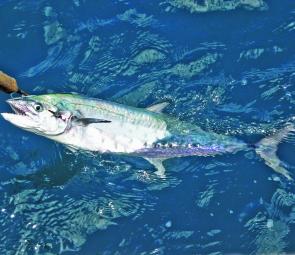
Gaffing mackerel in the head, ensures the maximum return of clean flesh fillets.
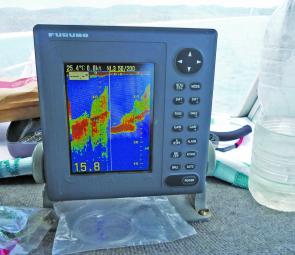
A school mackerel was taken by vertical high-speed spinning through this school of frog mouthed pilchards (as seen on the sounder). The bait was hanging around a hard breakline/drop-off on the bottom. Two bite offs were scored on mullet fillets fishe
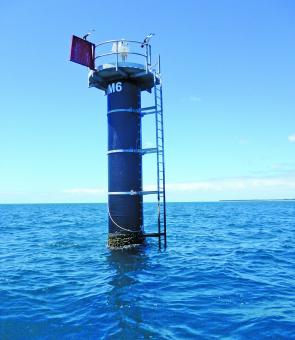
Post-type beacons have been a staple mackerel spot for high speed spinning for over a quarter of a century.
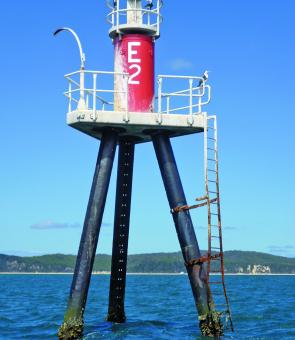
Tripod beacons, such as this one from the area formerly known as the four-beacons (south of Tangalooma), are legendary mackerel hot-spots.
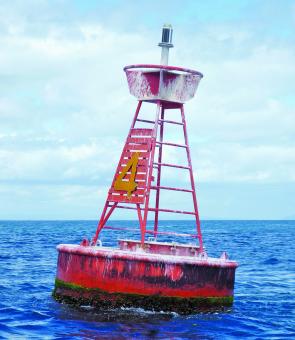
Floating beacons may not be the preferred option for mackerel (they are great for kingfish) but you wouldn't drive past one without giving it a try.




